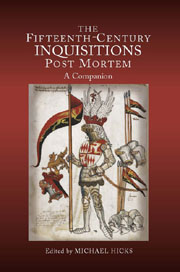Book contents
- Frontmatter
- Contents
- List of Tables and Figures
- List of Contributors
- Preface
- Glossary
- Abbreviations
- 1 Introduction
- 2 Crossing Generations: Dower, Jointure and Courtesy
- 3 The Lesser Landowners and the Inquisitions Post Mortem
- 4 Tales of Idiots, Signifying Something: Evidence of Process in the Inquisitions Post Mortem
- 5 The Value of Fifteenth-Century Inquisitions Post Mortem for Economic and Social History
- 6 ‘Notoriously Unreliable’: The Valuations and Extents
- 7 The Descriptions of Land Found in the Inquisitions Post Mortem and Feet of Fines: A Case Study of Berkshire
- 8 Re-assessing Josiah Russell's Measurements of Late Medieval Mortality using the Inquisitions Post Mortem
- 9 A Great Historical Enterprise: The Public Record Office and the Making of the Calendars of Inquisitions Post Mortem
- 10 Writs and the Inquisitions Post Mortem: How the Crown Managed the System
- 11 ‘Thrifty Men of the Country’? The Jurors and Their Role
- 12 Place-Names and Calendaring Practices
- Index
10 - Writs and the Inquisitions Post Mortem: How the Crown Managed the System
Published online by Cambridge University Press: 05 February 2013
- Frontmatter
- Contents
- List of Tables and Figures
- List of Contributors
- Preface
- Glossary
- Abbreviations
- 1 Introduction
- 2 Crossing Generations: Dower, Jointure and Courtesy
- 3 The Lesser Landowners and the Inquisitions Post Mortem
- 4 Tales of Idiots, Signifying Something: Evidence of Process in the Inquisitions Post Mortem
- 5 The Value of Fifteenth-Century Inquisitions Post Mortem for Economic and Social History
- 6 ‘Notoriously Unreliable’: The Valuations and Extents
- 7 The Descriptions of Land Found in the Inquisitions Post Mortem and Feet of Fines: A Case Study of Berkshire
- 8 Re-assessing Josiah Russell's Measurements of Late Medieval Mortality using the Inquisitions Post Mortem
- 9 A Great Historical Enterprise: The Public Record Office and the Making of the Calendars of Inquisitions Post Mortem
- 10 Writs and the Inquisitions Post Mortem: How the Crown Managed the System
- 11 ‘Thrifty Men of the Country’? The Jurors and Their Role
- 12 Place-Names and Calendaring Practices
- Index
Summary
This chapter is inspired by ten years of editing the inquisitions post mortem for the reign of Henry VI filed in the C 139 series at the National Archives. Accompanying the inquisitions are many hundreds of writs which the work also involved calendaring. The continuous processing of these somewhat formulaic little manuscripts did not put me off them, but made me become increasingly interested in their history, largely prompted by the scarcity of information about them. Identifying the writs and the sequence of their use is of obvious importance in understanding them, but discussion that contextualises the production, development, and use of these writs in the medieval period is rare. A promising beginning was made by Maxwell-Lyte in the introduction to the first calendar of medieval inquisitions post mortem, published in 1904, where he wrote of the writ diem clausit extremum, the earliest and most commonly used writ to develop, that it ‘cannot be traced beyond the 39th year of that king [Henry III: 1254–55]; and to the very end of the reign it is possible to note occasional variations from the regular course’. It was ninety-nine years before any further substantive observations were made, when Parkin noted irregularities in the expected use of the writ amotus. This chapter is therefore a first pass in understanding the medieval writs associated with the inquisitions post mortem and related documents, using some of the information and ideas put together during the calendaring project.
- Type
- Chapter
- Information
- The Fifteenth-Century Inquisitions 'Post Mortem'A Companion, pp. 183 - 200Publisher: Boydell & BrewerPrint publication year: 2012



